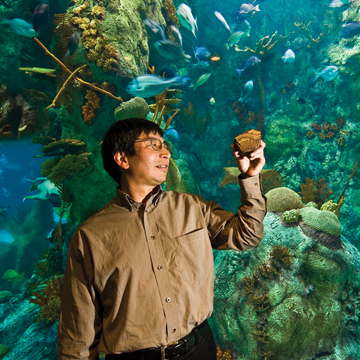
The physicist’s concept that the Earth coalesced from the stuff of stars doesn’t generally raise the issue of why massive formations of banded iron — some hundreds of kilometers long — began precipitating on Earth’s surface about 3.5 billion years ago and then ceased relatively suddenly, approximately 1.7 billion years ago.
Because these deposits provide much of industry’s iron resources and also carry information about Earth’s early surface conditions and climate changes, interested researchers have cast a wide net in trying to explain why the formations exist. But attempts to pin the rap on seasonal variations, surface temperature changes, and episodic seawater mixing all have foundered on assumptions requiring the unexplained oscillations of external forces.
IRON MAN – Yifeng Wang (6772) holds a piece of banded iron during a visit to the Albuquerque Aquarium. Yifeng and colleagues have proposed an explanation – published recently in Nature Geoscience – for the precipitation of banded iron deposits in the planet’s oceans billions of years ago. (Photo by Randy Montoya)
None of these theories could satisfactorily explain all the observations made by geologists, particularly the existence of structural bands in these deposits that alternate silica-rich layers with iron-rich layers.
A new solution proposed in an October issue of Nature Geoscience by principal investigator Yifeng Wang (6772) and colleagues may have the answer.
A key component of the process, Yifeng and his colleagues found in computer simulations, may have been the absence of aluminum in early oceanic rocks, an absence that chemically favored the formation of banded iron formations. The continual enrichment of oceanic crust by aluminum as Earth evolved ultimately ended the era of iron band formation.
A complete thermodynamic explanation by the researchers suggests that iron- and silicon-rich fluids were generated by hydrothermal action on the seafloor. Their calculations show that the formation of bands was generated by internal interactions of the chemical system, rather than from external forcing by unexplained changes such as ocean surface temperature variations.
“This concept of the self-organizational origin of banded iron formations is very important,” says Yifeng. “It allows us to explain a lot of things about them, like their occurrence and band thickness.
“My PhD advisor Enrique Merino [at Indiana University] was probably the first to consider banded iron formations as formed through self-organization,” says Yifeng. “We started to work on the issue about 15 years ago.” But difficulties in pinning down an actual mechanism persisted.
“Last year, Huifang Xu [at the University of Wisconsin at Madison] and I happened to talk about his work on astrobiology and then we talked about banded iron formations,” says Yifeng. “After that, I got interested again in the topic. Luckily,
I came across a very recent publication on silicic acid interactions with metals. With these new data, I did thermodynamic calculations. I looked at the results and talked to both Huifang and Enrique. The whole banded-iron-formation puzzle started to fit together nicely.”
Merino and Xu coauthored the paper with Yifeng, along with Hironomi Konishi, also at the University of Wisconsin at Madison.
“Our work has two interesting implications,” says Yifeng. “The Earth’s surface can be divided into four interrelated parts: atmosphere, hydrosphere, biosphere, and lithosphere. Our work shows that the lithosphere, that is, the solid rock part, plays a very important role in regulating the surface evolution of the Earth.
“This may have an implication to the studies of other planets such as Mars. Our work also shows that to understand such evolution requires a careful consideration of nonlinear interactions among different components in the system. Such consideration is important for prediction of modern climatic cycles.
“After all,” he says, “Earth’s system is inherently complex and the involved processes couple with each other in nonlinear fashion."